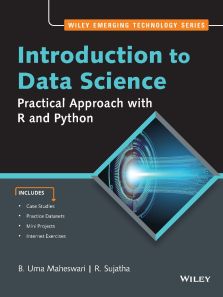Introduction to Data Science: Practical Approach with R and Python
ISBN: 9789354640506
For more information write to us at: acadmktg@wiley.com

Description
Introduction to Data Science: Practical Approach with R and Python covers all the fundamental concepts of Data Science in a concise manner. It offers a mix of insights and golden rules which would be needed in analyzing data. This book serves as a practical guide for Science/Engineering/MBA students – both at the undergraduate and postgraduate level interested in Data Science domain.
Chapter 1 Introduction to Data Science
1.1 Data Science
1.2 Brief History of Data Science
1.3 Increasing Attention to Data Science
1.4 Fundamental Fields of Study Related to Data Science
1.5 Data Science and Related Terminologies
1.6 Types of Analytics
1.7 Applications of Data Science
1.8 Data Science Process Model
Chapter 2 Introduction to R and Python
2.1 Introduction
2.2 R and RStudio Environment
2.3 Basics of R
2.4 Python Language and Python Environment
2.5 Basics of Python
Chapter 3 Exploratory Data Analysis
3.1 Introduction
3.2 Steps in Data Preprocessing
3.3 Understanding Data
3.3.1 Steps Involved in EDA Using R Programming
3.4 Looking at the Data
3.5 Visualizing Data
3.6 Dealing with Outliers
3.7 Dealing with Missing Values
3.8 Standardizing Data
3.9 Steps Involved in EDA Using Python Programming
3.10 Looking at the Data
3.11 Visualization the Data
3.12 Treatment of Outliers
Chapter 4 Data Visualization
4.1 Introduction
4.2 Data Visualization for Machine Learning
4.3 Data Visualization Techniques
4.4 Simple Data Visualization Using R
4.5 Data Visualization Using Ggplots in R
4.6 Data Visualization Using Python
4.7 Matplotlib Library
4.8 Seaborn Library
Chapter 5 Dimensionality Reduction Techniques
5.1 Dimensionality Reduction
5.2 Independent and Dependent Variables
5.3 Relationship between Variables: Correlation
5.5 Factor Analysis
5.5.4 Rotated Factor Matrix
5.6 Application of Factor Analysis Using Python Programming
Chapter 6 Types of Machine Learning Algorithms
6.1 Introduction
6.2 Supervised and Unsupervised Learning Algorithms
6.3 Supervised Learning Algorithm
6.4 Unsupervised Learning Algorithm
Chapter 7 Unsupervised Learning Algorithms
7.1 Introduction
7.2 Association Rule Mining
7.3 Conjoint Analysis
7.4 Clustering
7.5 K Means Clustering
Chapter 8 Text Analytics
8.1 Introduction
8.2 Unstructured Data
8.3 Word Cloud
8.4 Sentiment Analysis
8.5 Web and Social Media Analytics
Chapter 9 Supervised Learning Algorithms: Linear and Logistic Regression
9.1 Introduction
9.2 Simple Linear Regression
9.3 Multiple Linear Regression
9.4 Logistic Regression
Chapter 10 Supervised Learning Algorithms: Decision Tree and Random Forest
10.1 Decision Tree
10.2 Classification and Regression Technique
10.3 Random Forest
Chapter 11 Supervised Learning Algorithm: KNN, Naïve Bayes, and Linear Discriminant Analysis
11.1 K-Nearest Neighbors
11.2 Naïve Bayes Algorithm
11.3 Linear Discriminant Analysis
Chapter 12 Support Vector Machines and Artificial Neural Networks
12.1 Support Vector Machines
12.2 Artificial Neural Networks
Chapter 13 Time Series Forecasting
13.1 Introduction
13.2 Time Series Data
13.3 Visualizing the Time Series Data
13.4 Components of Time Series Data
13.5 Stationarity of the Data
13.6 Exponential Smoothening Model
13.7 Holt–Winters Model
13.8 ARIMA Model
Chapter 14 Ensemble Methods
14.1 Introduction
14.2 Dealing with Imbalanced Data
14.3 Ensemble Methods
14.4 Bias Variance Tradeoff
14.5 Bagging
14.6 Boosting
14.7 Synthetic Minority over Sampling Technique (SMOTE)
Chapter 15 Artificial Intelligence
15.1 Introduction
15.2 Artificial Intelligence
15.3 Deep Learning
15.4 Convolutional Neural Networks
15.5 Reinforcement Learning
Chapter 16 Applications of Analytics
16.1 Introduction
16.2 Application of Analytics in Healthcare
16.3 Application of Analytics in Agriculture
16.4 Application of Analytics in Business
16.5 Application of Analytics in Sports
16.6 Application of Analytics in Governance
Summary
Terms to Know
Review Questions
Exercise Problems
Internet Exercises
Mini Project
References
Answers to Multiple-Choice Questions
Interview Questions and Answers
Index

